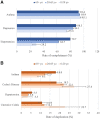Characterizing outpatient problem list completeness and duplications in the electronic health record
- PMID: 32620950
- PMCID: PMC7481031
- DOI: 10.1093/jamia/ocaa125
Characterizing outpatient problem list completeness and duplications in the electronic health record
Abstract
Objective: The study sought to characterize rates of problem list completeness and duplications in common chronic diseases and to identify any relationships that they may have with respect to disease type, demographics, and disease severity.
Materials and methods: We performed a retrospective analysis of electronic health record data from Partners HealthCare. We selected 8 common chronic diseases and identified patients with each of those diseases. We then analyzed each patient's problem list for completeness and duplications and also collected information regarding demographics and disease severity. Rates of completeness and duplications were calculated for each disease and compared according to disease type, demographics, and disease severity.
Results: A total of 327 695 unique patients and 383 404 problem list entries were identified. Problem list completeness varied from 72.9% in hypertension to 93.5% in asthma, whereas problem list duplications varied from 4.8% in hypertension to 28.2% in diabetes. There was a variable relationship between demographic factors and rates of completeness and duplication. Rates of completeness were positively correlated with disease severity for most diseases. Rates of duplication were consistently positively correlated with disease severity.
Conclusions: Incompleteness and duplications are both important issues in problem lists. These issues vary widely across different diseases and can also be impacted by patient demographics and disease severity. Further studies are needed to investigate the effect of individual user behaviors and organizational policies on problem list utilization, which will aid the development of interventions that improve the utility of problem lists.
Keywords: electronic health records; electronic medical records; problem lists.
© The Author(s) 2020. Published by Oxford University Press on behalf of the American Medical Informatics Association.
Figures



References
-
- Holmgren AJ, Co Z, Newmark L, et al.Assessing the safety of electronic health records: a national longitudinal study of medication-related decision support. BMJ Qual Saf 2020; 29 (1): 52–9. - PubMed
-
- McGinn TG, McCullagh L, Kannry J, et al.Efficacy of an evidence-based clinical decision support in primary care practices: a randomized clinical trial. JAMA Intern Med 2013; 173 (17): 1584–91. - PubMed

